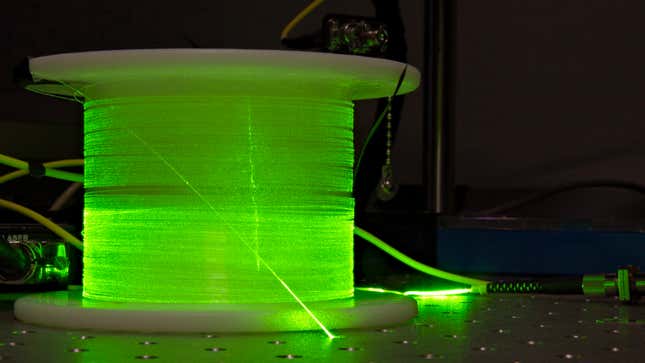
Although high-speed wireless technologies like Wifi 6E and 5G dominate news headlines, analog, and optical cables are still the backbone of the internet, and for good reason. Researchers in Japan just set a new fiber optic data transmission record with a technique that’s compatible with existing cable infrastructure, meaning a real-world implementation is entirely possible, and not just limited to a laboratory setting.
Researchers from Japan’s National Institute of Information and Communications Technology (NICT) successfully sent data down a custom multi-core fiber optic cable at a speed of 1.02 petabits per second over a distance of 51.7 km. That’s the equivalent of sending 127,500 GB of data every second, which, according to the researchers, is also enough capacity for over “10 million channels of 8K broadcasting per second.” As New Atlas points out, that’s also 100,000 times faster than the promised next generation of high-speed gigabit connections providing internet to home users.
In December of 2020, NICT actually made the first successful 1 petabit per second transmission of data over a standard diameter fiber optic cable, and while a speed improvement to 1.02 petabits per second just a year-and-a-half later is certainly an impressive achievement, what makes this time around so exciting is the technology used to break the record.
In 2020, the NICT researchers sent the data down a fiber optic cable with a single core but used a multi-mode technique where multiple signals were mixed together during the transmission. In total 15 “modes” were sent down the fiber together, and while the speed achievements were impressive, the multi-mode technique requires special hardware to unscramble the signals and extract useable data, requiring the development and deployment of new integrated circuits across an entire network and expensive upgrades, making it a harder sell to internet service providers despite the massive bandwidth gains.
This time around, the researchers did away with the mixed-signal, multi-mode approach and instead reduced the transmission to just four “modes” each sent down one of four cores inside a custom fiber optic cable with a standard diameter. Imagine a plastic straw with four thinner straws stuffed inside each carrying a different flavor of soda: a gross simplification of what the researchers created. But the multi-core cable wasn’t the only innovation that made this record-setting data transfer possible, it also relied on some very technical optical amplification systems and signal modulation approaches, as the NICT researchers describe:
In this experiment, by broadening the Raman amplification bandwidth to the full S-band and using customized thulium-doped fiber amplifiers (TDFAs) for S-band and extended L-band erbium-doped fiber amplifiers (EDFAs), we were able to use a record 20 THz optical spectrum with total of 801 x 25 GHz spaced wavelength channels, each with dual-polarization-256 QAM modulation for high spectral density in all wavelength bands.
The most important part is that this second breakthrough relies on hardware and techniques that are completely compatible with conventional transceiver hardware that is already in place across the country. New fiber optic cabling will need to be installed, but since the researchers limited the size of their multi-core cable to standard dimensions, it would be completely compatible with existing infrastructure, greatly reducing upgrade costs. As 5G becomes more widespread, and with 6G just around the corner, the country’s demand for data is going to continue to increase by leaps and bounds, but an innovation like this promises to give internet providers a sizeable head start for at least a few years.